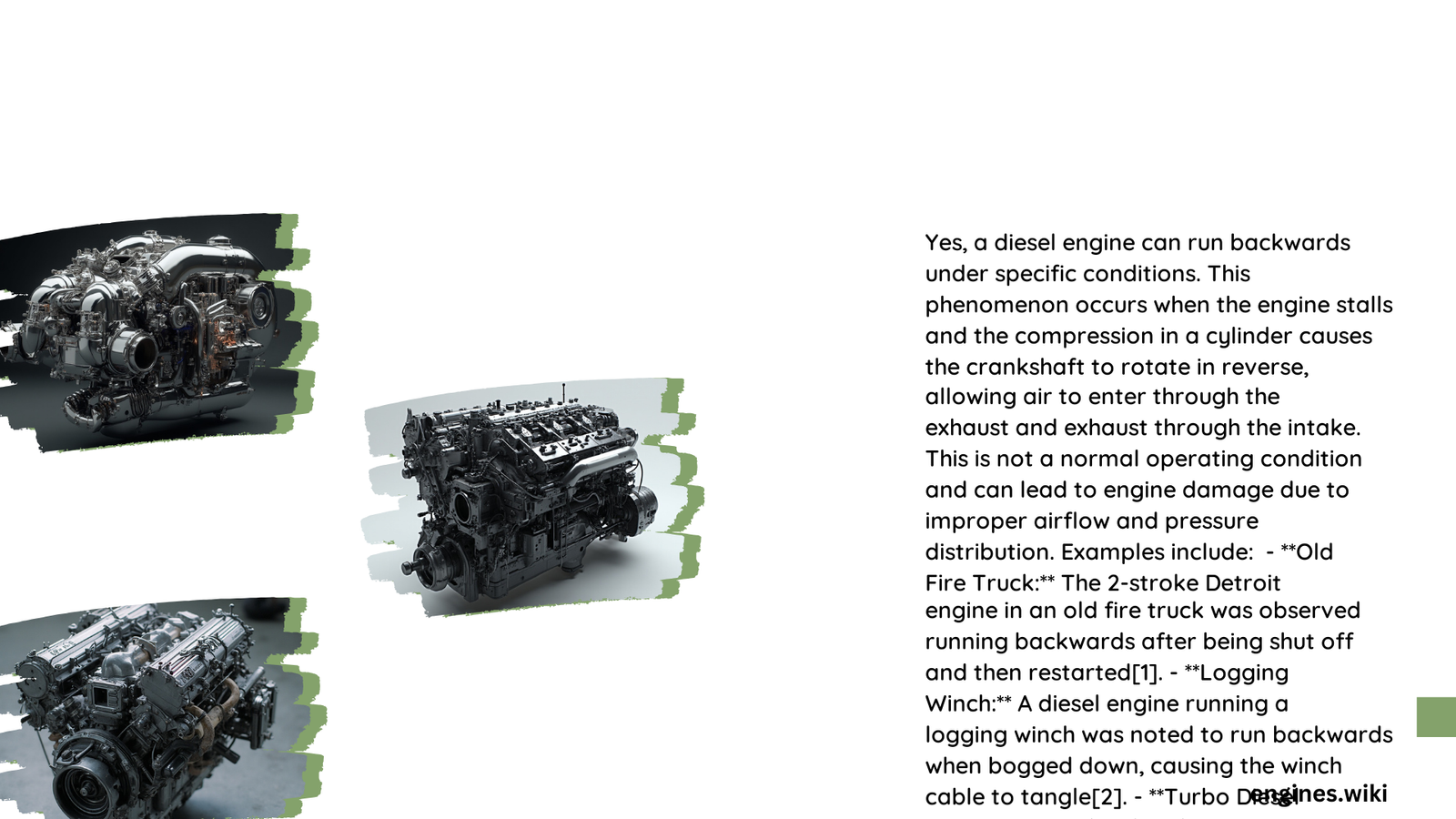Diesel engines, particularly in marine applications, can be designed to run backwards. This capability requires specific mechanical adjustments and design features. Reverse operation involves modifying camshaft timing, fuel injection, and air intake systems. While possible, running a diesel engine backwards presents technical challenges and safety considerations. This article explores the mechanics, limitations, and precautions associated with reverse diesel engine operation.
What Are the Mechanics Involved in Reverse Diesel Engine Operation?
The process of running a diesel engine backwards involves several key mechanical adjustments:
- Camshaft Adjustment: The camshaft must be repositioned to alter the timing of fuel injection, air intake, and exhaust. This is typically achieved through:
- Axial movement of the camshaft
- Use of a separate reversing cam
-
Employment of lost-motion clutches or servo motors
-
Fuel Pump Timing: Critical for reverse operation, fuel pump timing requires modification. This often involves:
- Shifting the cam follower roller
-
Using compressed air to actuate a pneumatic cylinder
-
Air Injection Timing: For engines with air starting systems, the air injection timing must be adjusted to match the new firing order in reverse.
What Design Limitations Affect Reverse Diesel Engine Operation?

Several design factors impact a diesel engine’s ability to run backwards:
- Unidirectional Design: Most medium-speed diesel engines are optimized for unidirectional operation.
- Component Retiming: Fuel pumps, inlet valves, and exhaust valves require retiming for reverse operation.
- Additional Mechanisms: Lost-motion clutches, servo motors, and pneumatic valves add complexity.
What Technical Challenges Arise When Reversing a Diesel Engine?
Reversing a diesel engine presents several technical hurdles:
- Precise Timing Adjustments: Ensuring accurate fuel and air injection timing is crucial and challenging.
- Increased Mechanical Complexity: Additional components raise the risk of mechanical failures.
- Safety Interlocks: Preventing accidental reverse operation requires complex safety systems.
Performance impacts include:
- Reduced Power Output: Engines typically operate at lower power in reverse for safety and control.
- Increased Fuel Consumption: Reverse operation is generally less efficient, leading to higher fuel use.
What Specific Design Features Enable Reverse Diesel Engine Operation?
Key design elements for reverse-capable diesel engines include:
- Dual-Purpose Camshafts: Featuring separate cam profiles for forward and reverse operation.
- Lost-Motion Clutches: Allow for repositioning of cam followers to adjust timing.
- Pneumatic Systems: Utilize compressed air to actuate timing adjustment mechanisms.
| Design Feature | Purpose |
|---|---|
| Dual-Purpose Camshafts | Provide separate timing for forward and reverse |
| Lost-Motion Clutches | Enable cam follower repositioning |
| Pneumatic Systems | Actuate timing adjustment mechanisms |
How Can a Diesel Engine Be Safely Reversed?
Safe reversal of a diesel engine requires careful procedures:
- Use of Telegraph System: Signal direction change and stop the engine before reversing.
- Precise Timing Adjustments: Ensure correct positioning of camshaft and cam followers.
- Safety Checks: Verify oil pressure, water pressure, and other critical systems.
- Engage Safety Interlocks: Prevent accidental reverse operation.
Potential Risks:
- Mechanical failure due to increased complexity
- Accidental reverse operation if safety systems fail
What Are the Cost and Time Implications of Reverse Diesel Engine Operation?
Implementing reverse capability in diesel engines impacts both cost and operational efficiency:
- Increased Manufacturing Costs: Additional mechanisms and safety features raise production expenses.
- Extended Reversal Time: The process of stopping, adjusting, and restarting in reverse can take several minutes.
- Maintenance Costs: More complex systems require additional maintenance and potential repairs.
In conclusion, while diesel engines can be designed to run backwards, this capability comes with significant mechanical complexity, safety considerations, and operational challenges. The decision to implement reverse operation must carefully weigh these factors against the potential benefits in specific applications, particularly in marine environments where maneuverability is crucial.
